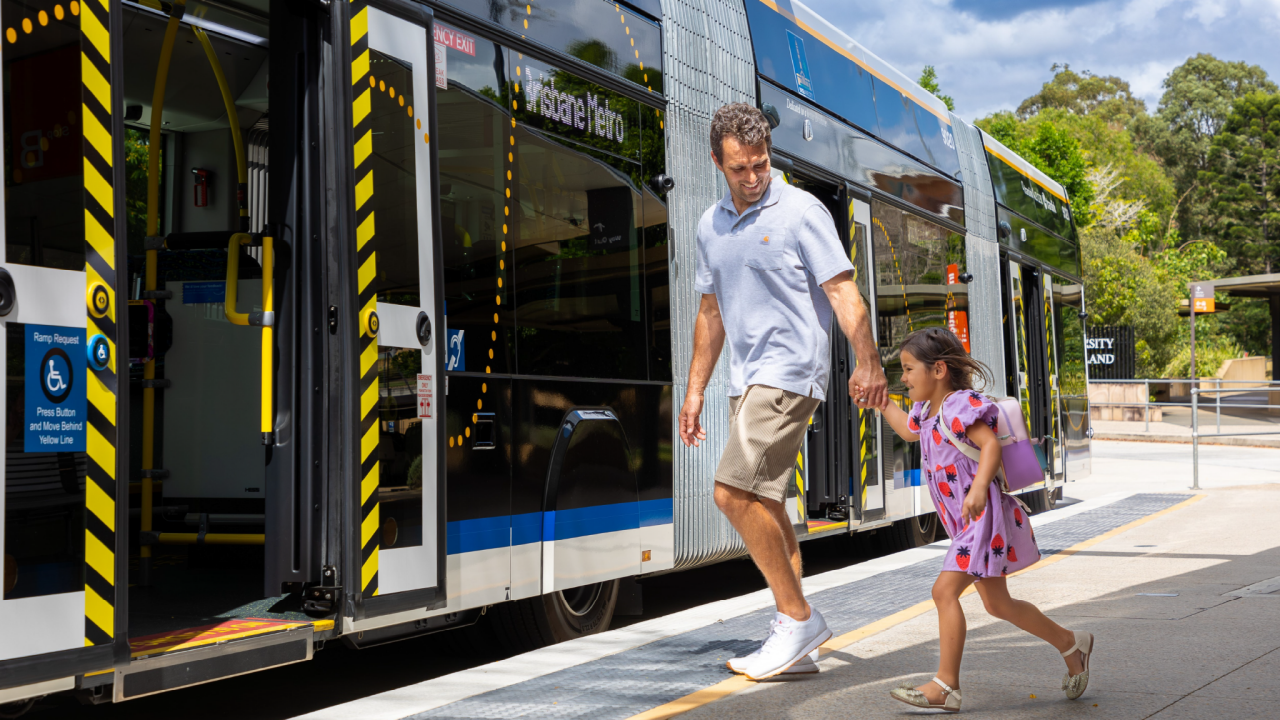About Brisbane Metro
Brisbane City Council is meeting the demand for fast and reliable ways to travel by delivering turn-up-and-go Brisbane Metro bus rapid transit (BRT) services.
With new and upgraded infrastructure, Brisbane Metro will reduce bottlenecks and congestion by better utilising our busways with a new fleet of high-capacity, fully electric metros.
Brisbane's New Bus Network is here
Brisbane is growing and we need a bus network that grows with us — this means changing the way you travel.
Brisbane's New Bus Network has launched, alongside a new metro route — M1 from Eight Mile Plains to Roma Street.
The new network is improving reliability to get you where you need to go, at the times you want to travel.

Turn-up-and-go
Metros every 5 minutes on weekdays and
24 hours on weekends
A growing network
More metro and bus services, more often
Built for Brisbane
A more reliable network for our city
Helpful links
Service delivery timeline
Stage 1 - 2024
Metro vehicle testing and route 169 customer preview.
Stage 2 - 28 January 2025
Launch of metros on the M2 route (UQ Lakes to RBWH).
Stage 3 - 30 June 2025
Launch of Brisbane’s New Bus Network and metros on the M1 route (Eight Mile Plains to Roma Street).
Stage 4 - 29 September 2025
Delivering the new Adelaide Street bus tunnel for bus and metro services.
Stage 5 - Late 2025 onward
Expanding services and exploring metro extensions.
Metro routes and stations
Brisbane Metro services include 2 high-frequency, high-capacity routes, running every 5 minutes on weekdays and 24 hours on weekends:
- M1 - Eight Mile Plains to Roma Street
- M2 - UQ Lakes to Royal Brisbane and Women's Hospital (RBWH).
Use Translink's journey planner to plan your new metro and bus journeys.
Council is also exploring ways to expand Brisbane Metro BRT across our city.

Frequently asked questions
Brisbane Metro is a high-capacity, high-frequency public bus rapid transit (BRT) system that links the city to the suburbs, getting you where you need to go at the times you want to travel.
The electric metro fleet will integrate seamlessly into busway operations as part of Brisbane's New Bus Network, which will involve new ways to travel around our city.
Metros include the high-quality and high-capacity features of light rail vehicles, however they avoid the need for tracks and overhead line equipment, by travelling on the existing busway infrastructure.
This city-shaping project is fully funded in partnership with the Australian Government.
Bus rapid transit (BRT) is a best-practice public transport model used by cities around the world to provide high-frequency bus services using dedicated busways that are separated from cars.
This solution was chosen for Brisbane Metro to maximise the use of Brisbane’s world-class busways and deliver fast, reliable public transport, for now and for the future.
The M1 route services bus stations at:
- Eight Mile Plains
- Upper Mt Gravatt
- Griffith University
- Holland Park West
- Greenslopes
- Buranda
- Mater Hill
- South Bank
- Cultural Centre
- City Hall / King George Square
- Roma Street.
The M2 route services bus stations at:
- UQ Lakes
- Boggo Road
- PA Hospital
- Mater Hill
- South Bank
- Cultural Centre
- City Hall / King George Square
- Roma Street
- Normanby
- QUT Kelvin Grove
- Herston
- Royal Brisbane and Women’s Hospital (RBWH).
Metro vehicles feature an automatic ramp in the first compartment, which can be deployed upon request.
The first compartment has three large mobility bay areas, which feature a number of support features, including railings, padded back rests and passive restraint handles.
Learn more about onboard metro accessibility features.
The City Hall / King George Square renaming will make it easier for Brisbane residents and visitors to navigate the bus network. This name change better reflects the station’s proximity to the key Brisbane landmark, City Hall, and is aligned with the naming conventions of other Australian and international metropolitan cities.
The new station name will be rolled out progressively from 28 January 2025, with initial updates seen on bus destination signs, passenger information displays, some wayfinding signage and Council’s websites. Full station rebranding will occur later in 2025.







